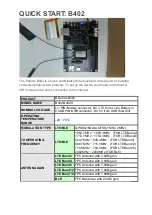
20
CA S M
Intermediate plate installation
Fig.11
Step 1
Mount the motor (M) on the intermediate plate (ZW) by in-
serting the square seal without cut-out (D1) in between and
tightening it using all the Allen screws (S3). When assem-
bling, note the alignment of the intermediate plate marking (X).
Step 2
Attach the linear unit (LE) to the intermediate plate (ZW), in-
sert the square seal with cut-out (D2) and hand tighten the
four screws (SB).
NOTE
Do not tighten the screws (SB) until step 5 chapter 7.4.4.
7.4.4 Timing belt installation
Fig. 12
Step 1
Push the linear unit (LE) as far as possible towards the mo-
tor (M) and tighten the screws (SB) by hand.
Place the two clamping sleeves (CS) on the shaft of the lin-
ear unit and the motor. Take the timing belt and insert the
pulleys (P/PF).
Step 2
Push the pulleys over the clamping sleeves. The flanged pul-
ley (PF) has to be on the shaft of the linear unit. Push the
flanged pulley and clamping sleeve as far as possible on the
screw trunnion and align the pulley (P) and the 2nd clamping
sleeve on the motor side as follows:
• CASM-32: Push the pulley as far as possible
• CASM-40/63: Position the pulley by placing the assembly
tool (MH) on the intermediate plate and pushing the pulley
as far as possible.
Step 3
Secure the pulley by tightening the nut (torque as per table 3)
and countering at the same time with a hexagonal wrench.
Tab. 3
Pulley fixation - tightening Torque (MA)
Pulley
Torque MA
CASM–32–1FK7015
GT3–3M–Z18
5 Nm
CASM–40–1FK7022
GT3–3M–Z24
20 Nm
CASM–63–1FK7034
GT3–5M–Z22
40 Nm
Step 4
Place the central pretension screw (SP) in the side bore of
the intermediate plate (ZW, fig.12) and tighten the timing belt
(Z) using the pretension screw (SP).
NOTE
Loosen the special screw (SB, fig. 11) if the belt cannot be
tightened.
Step 5
Measure the timing belt tension using a suitable frequency
measurement device. Adjust the pretension screw (SP) until
the required belt tension is reached and tighten the screws
(SB) according to table 2.
Tightening the pretension screw (SP) increases the natural
frequency of the timing belt (table 4). Excessive preloads
can lead to increased wear in the bearing of the linear unit
(LE) or motor (M) due to radial loading. Once the correct fre-
quency is set, secure the special screws (SB) and check the
timing belt frequency again.
Tab. 4
CASM–32–
1FK7015
CASM–40–
1FK7022
CASM–63–
1FK7034
Natural frequency 565 Hz ±8
525 Hz ±8
345 Hz ±8
Strand deflection 1 mm @ 8 N
1,2 mm @ 15 N 1,6 mm @ 20 N
Replace interval for all timing belts: 2 Mio cycles
CS
CS
P
PF
Z
D1
ZW
Z Z0
X
D2
D3
S2
S1
LE
ZB
SB
SP
S3
M
MH
LE
M
SB
ZW
SP










































